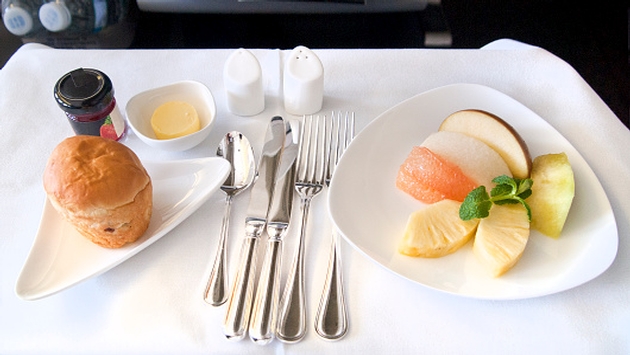By Charu Suri
The words “airline food” used to mean something very different.
Gone is the Golden Era of Pan Am where First Class dinners would last three hours, complete with seven courses served on fine china presented smartly on linen accompanied with a vase of flowers.
But the fortunes of meals served aloft may be changing, and international carriers have been innovators in this aspect. Air France upped the ante with its a la carte options in 2014, offering cocktails, gourmet selections and ice cream on elegant trays designed by Eugeni Quitllet, a student of legendary French designer Philippe Starck.
Thanks to the deregulation of the airline industry in India, niche carriers like Indigo Airlines offer snacks like Punjabi Vegetable Samosa, noodles and masala tea for purchase.
U.S.-based carriers are sensing the need to up the game, as seen in some recent partnerships forged in the world of gourmet cuisine.
Delta Air Lines announced in December that it would further its partnership with Danny Meyer’s Union Square Hospitality Group (on the coattails of its alliance with Blue Smoke restaurant in 2013) with an exclusive menu.
The partnership is helmed by Chef Nick Anderer, who honed his culinary chops at Babbo and Gramercy Tavern before teaming up with Danny Meyer in 2010 to open Maialino. Marta was the sequel, serving Roman-inspired pizza on New York City’s East Side.
But the new menu, which started in the Delta One cabin on select international flights starting Dec. 1, doesn’t involve pizza. “The FAA wouldn’t allow a wood-fired oven anyway and there’s more to Marta” said Beatriz Sims, General Manager of International Menu and Product Development for Delta.
Sims is quick to acknowledge that Delta did not arrive at the menu overnight. Working with local purveyors to ensure that dishes are at the peak of their freshness were prerequisites for smooth sailing, said Sims. “Scalability is everything; we tested the waters with our consultant chefs,” she said. For that very reason, this new menu won’t extend into the expanse of the economy cabin.
One hardly thinks of freshness and seasonality when it comes to airline food, but Delta wanted to jump through that hoop. The menu will include some of the restaurant’s favorite dishes including Nick’s Classic Chicken Meatballs, Grilled Nebrodini Mushrooms and Grilled Lamb Chops. The wines too, were carefully selected after working with master sommelier Andrea Robinson.
But what does this mean for the future of airline cuisine?
Delta itself is no stranger to shaking things up a bit. Its failed “Song” low-cost carrier, which operated from 2003-2006, boasted leather seats, free beverages, meals for purchase and even customized cocktails created by nightlife and hotel bar pioneer Rande Gerber.
Even Frontier Airlines, who once upon a time served warm chocolate chip cookies, called them off in 2012, replacing them with Goldfish and Animal Crackers. Warm chocolate chip cookies were, after all, a Toll House Inn invention, a nod to the popular restaurant in Whitman, Massachusetts. In other words, warm cookies were symbols of cooking and sound culinary sensibility. Replacing them with crackers signaled rougher waters ahead for hungry travelers, the equivalent of substituting a brown bag lunch for a Michelin-star meal.
But the future of airline food does not look quite so bleak. There are several airlines who are doing culinary magic of sorts, from Qantas (partnered with famed Australian restaurateur Neil Perry) to Virgin Atlantic, which samples at least 500 dishes to create each new menu, to Air New Zealand, which serves over one million bottles of wine each year.
In a consolidation-bound industry, which treats meals as ancillary revenues, winning the hearts of consumers through their appetites may be the wave of the future.
Steele Luxury Travel
www.SteeleTravel.com

